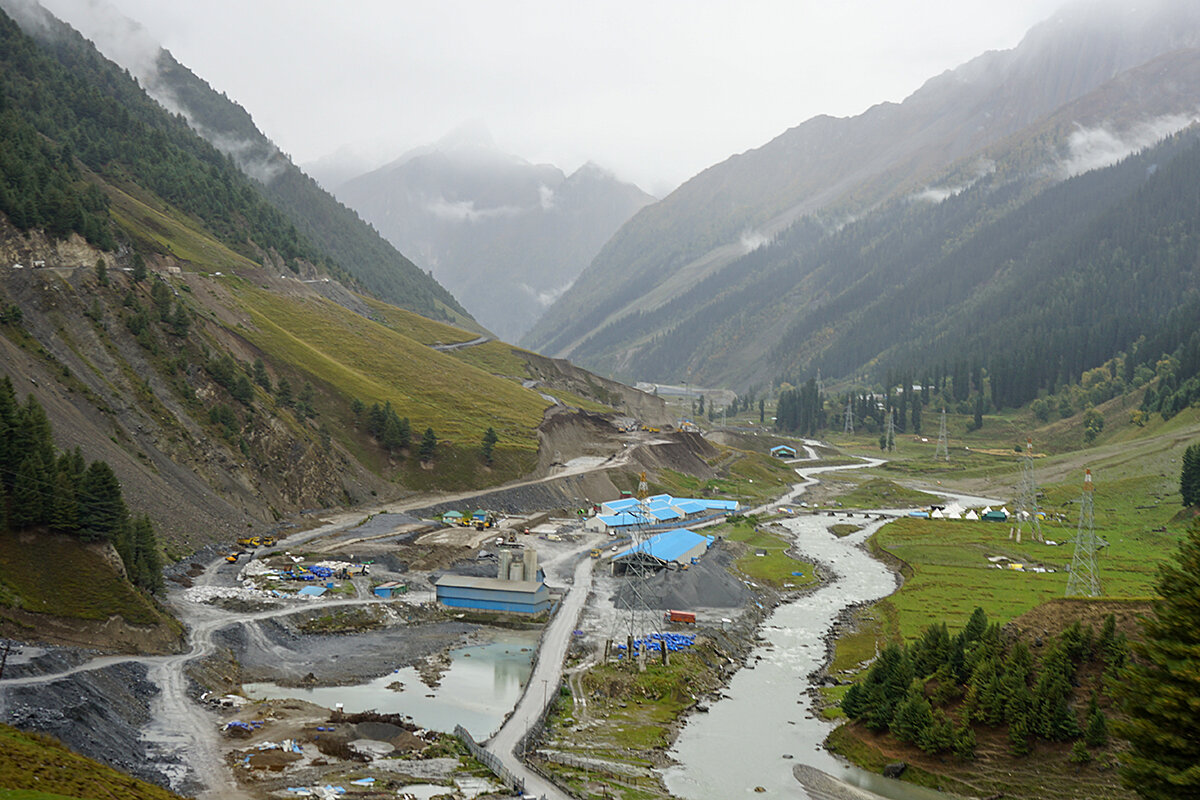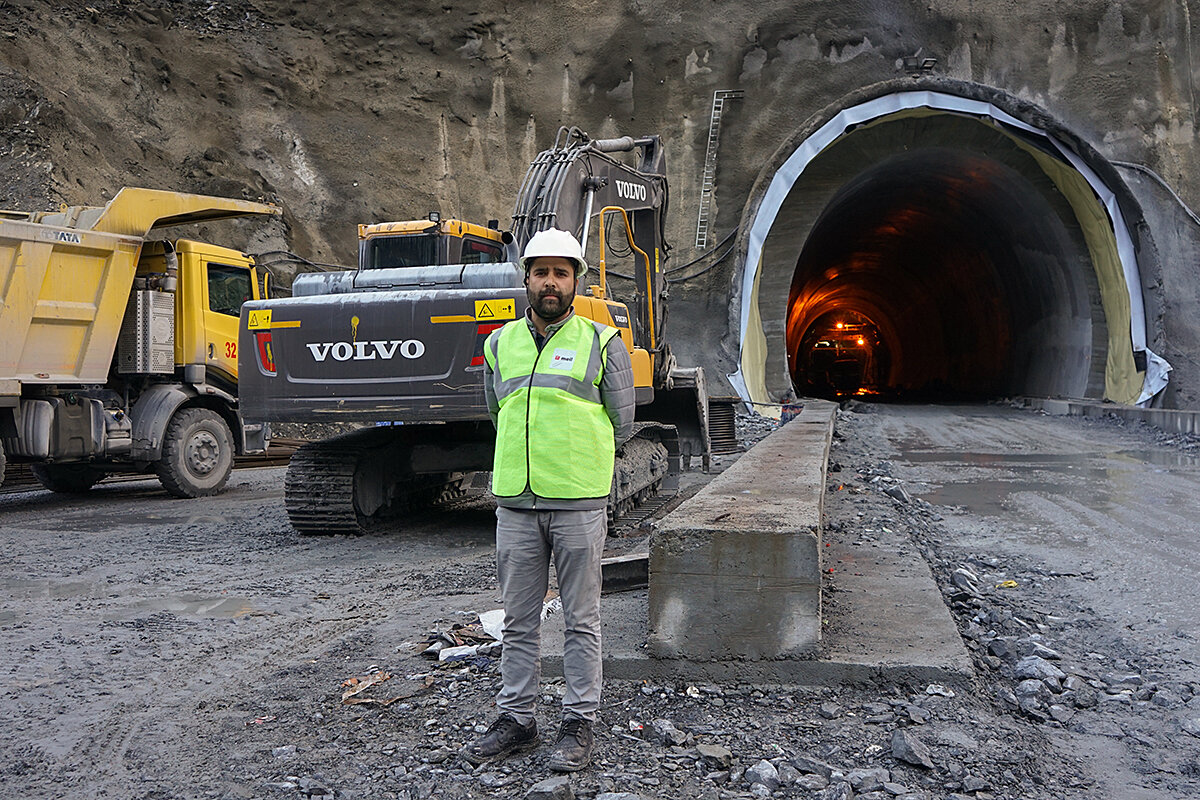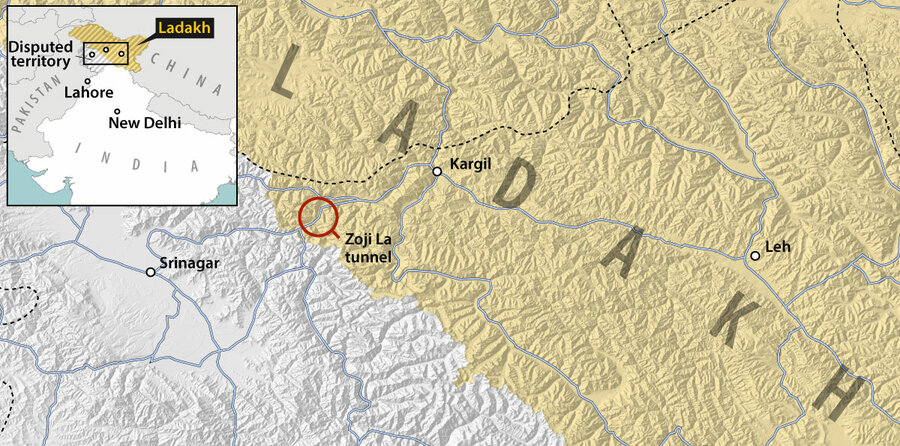Risky tunnel project promises security, prosperity in northern India
Loading...
| Zoji La, India
From beneath the brim of his helmet, Irshad Hussain watches workers march through icy gusts of wind into the Zoji La tunnel – a project which will be India’s longest road tunnel once completed. Years of experience have taught the safety officer the risks of burrowing into the Himalayas, and he’s keeping a close eye on the workforce to make sure everyone’s wearing their safety gear and following best practices.
“We are constantly fighting with nature to make this project a success,” he says, “but the real triumph will be completing the tunnel without any of these brave men getting hurt.”
Costing $830 million to build, the 8-mile-long roadway will help provide all-weather connectivity to Ladakh, an Indian territory that shares a contentious border with China. Locals welcome the tunnel, saying it will lower the costs of living during harsh Himalayan winters, but the main driver is national security.
Why We Wrote This
A story focused onNational security concerns have Delhi rushing to get more troops and resources to the India-China border. A potential upside? Greater connectivity for the people of Ladakh, a long-isolated region in northern India.
The Zoji La tunnel – which will cut travel times through the avalanche-prone mountain pass from 3 hours to 15 minutes – is part of a broader infrastructure push in the region, launched after a 2020 border clash killed 20 Indian soldiers and four Chinese soldiers. It was the deadliest skirmish between the two countries’ armies in more than 50 years, and tensions don’t appear to be waning – making access to the de facto boundary a priority.
“We cannot fight a war with China in Ladakh for more than 10 days in the present situation,” says Harpal Singh, head of the tunnel project. “With this tunnel that will change. Our forces will be able to have better connectivity, they can ferry more men and machinery.”
Security catch-up
Much of Ladakh sits more than 10,000 feet above sea level, and temperatures here can plummet to minus 40 degrees Fahrenheit. For around half the year, a combination of bad weather and poor infrastructure means that road connectivity is essentially nonexistent, forcing civilians and military personnel to stockpile everyday supplies.
“The Indian army does lots of logistic dumping in Ladakh for winter,” says retired Maj. Gen. Amrit Pal Singh, who served as the Indian army’s chief of operational logistics for the region. Keeping kerosene, ammunition, and food stocked throughout the winter months has always been a challenge, he says, but especially now that the number of Indian troops in the region has doubled.
“It is easy for the Chinese because they are sitting on Tibetan plateau,” he adds. “Their infrastructure is way ahead of us.”
With the Indian government anxious to catch up, the construction company in charge of Zoji La tunnel – Megha Engineering and Infrastructures Limited – has found ways to keep working even in the extreme winter conditions.
Mr. Singh says they keep months of medicine, food, and cooking gas on hand. The company provides 3,000 workers and engineers accommodations near the construction site as well as protective clothes. Work on Zoji La tunnel started just three months after the border clash, and the team has completed about 2.5 miles of drilling so far, with the rest expected to finish by next year. The tunnel should be fully operational by 2026.
Despite careful preparation, risks remain.
“These mountains are tectonically very active,” says Mehraj Ud Din, geotechnical head of the Zoji La tunnel project. “This all makes our job more complicated as we have to constantly use concrete to create equilibrium after boring.”
The area also receives heavy snowfall from November to April, and this January, a huge avalanche killed two laborers near the construction site. The incident, which also damaged several machines, suspended work for seven weeks.
“We have to be always extra cautious,” says Mohammad Altaf, a worker from a nearby village who gets to visit his family once every three months. “Working in this kind of situation needs a lot of skills and dedication.”
Boon for the region
Ladakh is home to roughly 300,000 people, spread across an area the size of West Virginia.
“All-weather connectivity was a long-pending demand of our people,” says Konchok Stanzin, a local councilor.
During the coldest months, prices of gas and food skyrocket, and travel is largely limited to air routes, which also become more expensive. At times, he says, the one-hour flight from Ladakh to New Delhi could cost the same as a flight from New Delhi to New York.
“After the tensions escalated on the border, many developmental projects are being carried out,” he says. “We are seeing many roads and bridges coming up.”
In January, Defence Minister Rajnath Singh inaugurated 28 infrastructure projects aimed at strengthening the border, including the Zoji La tunnel. It’s not just about the number of projects, but also the pace. A year after the clash on the border with Chinese troops, India established “centres of excellence” for the government’s Border Roads Organisation to speed up the construction of more than 30,000 miles of dual-use roads and bridges, as well as 19 airfields and four tunnels. These projects are mostly near, or leading to, the disputed border with China.
Some security experts say India’s infrastructure push could irk China and provoke further conflict. But former Indian army officer Amrit Pal Singh sees this as a reason to double down on construction.
“China has used India’s infrastructure development near the border as an excuse to escalate conflict and make incursions,” he says. “In this kind of situation, we have to react and cannot let them take any piece of our land.”
Sajid Ali, a research scholar from the town of Kargil in Ladakh, believes the tunnel and other infrastructure projects will be a boon for the region.
“Those people who can afford it usually move out of Ladakh during the winter season,” he explains, but all-weather connectivity will allow for increased tourism, regular supplies of essentials, and access “to better health care facilities throughout the year.”
“It will be a dream come true for us,” he says.









